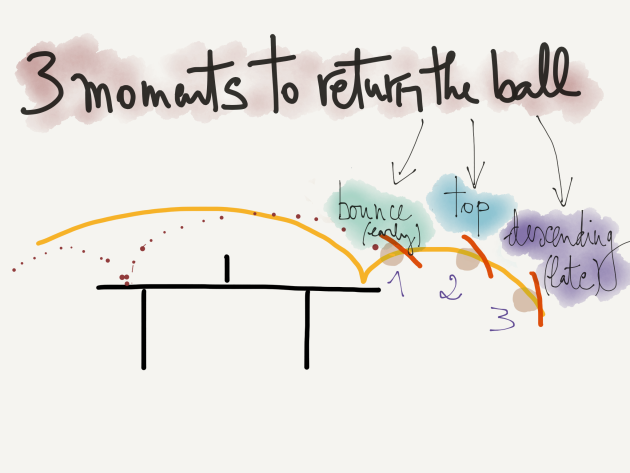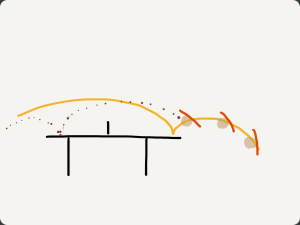Combining stroke time with the direction and angle
In order to rally, direct play or enter into a duel, the player returns the ball to a specific location (long or short), quickly or slowly (a rounded or flat trajectory), depending on where the opponent is positioned. The contact with the ball is essential here – it is a crucial link between intent and execution, which we will explore further in the stroke
diversification step (Push then Strike then Spin).
The table tennis student will master these progressively, depending on the stroke timing (near the bounce-early or farlate).
When you have stabilised your preferred position, combined with a racket angle, then you will be able to change this timing (early, peak, late) depending on the situation you're in and whether you are attacking or defending.
In this video, we can see a student who takes the ball on the rise, after the bounce. The ball tends to rise up after racket contact because the blade is open, or vertical. The stroke movement is more from bottom to top rather than back to front. We can see an improvement in her adjustment after 9 or 10 strokes, and this student can compare this stroke with the results she got on her first attempts.
Advice from the coach:
Always adjust the angle of the racket with the moment of contact on the ball's trajectory.
The 3D animation below shows you a position which is incompatible with the opening of the racket at certain contact times:
if I hit the ball at the top of the bounce with a vertical blade
if I open my racket on the bounce
if I close my racket too much...
Some students adapt by changing their movement at the moment of contact.
This student modifies his stroke according to whether he takes the ball later (attacking stroke) or earlier (a control block). Here we can see that he sets himself up by placing his racket side foot behind, in order to take a bigger swing and gain
more speed, when the ball is rising. For an earlier contact, near the bounce, he brings this “racket foot” forward to get closer to the ball.
The animation below shows the best angles to return the ball.
Here's the solution which lets you return the ball faultlessly.
This adjustment to the opening of the racket can also give you some problems on the backhand.
Here, the player does not change the angle of his racket when he steps back or forward to the bounce; as such, he cannot produce an adapted trajectory or add variety to cause problems for his opponent.
This left-handed player in the following video does not change his stroke (topspin), but rather closes the face of his racket when he moves in closer to the bounce.
However, we can see here that he is not fully effective. The risk taken with the speed he's unleashed means he has to ease up (forearm-wrist) and ensure full precision upon impact (keeping the angle by tightening his fingers' grip on the racket).
With a little work, you will be able to attack using the same type of technical stroke at different moments; you will just need to change the direction of the blade and the speed of the racket upon impact, like for this player...
SITUATIONS
Exercise 1: In this exercise, you will seek three points of contact on the trajectory after the bounce. While you do this, you will adapt the angle of your racket (the closer you are to the bounce, the more you have to close it). |

Exercise 2:
During the match, choose one stroke moment to use and another observing player will count how many successful strokes you manage.
Advice from the coach:
It is also possible during the warm-up to position yourself across the tables, without moving, in order to focus on the direction of the racket and the speed you need to use.






